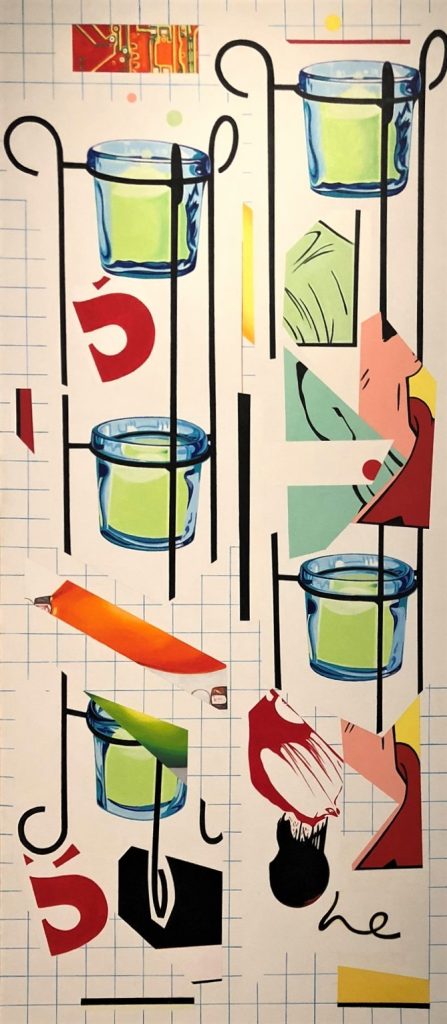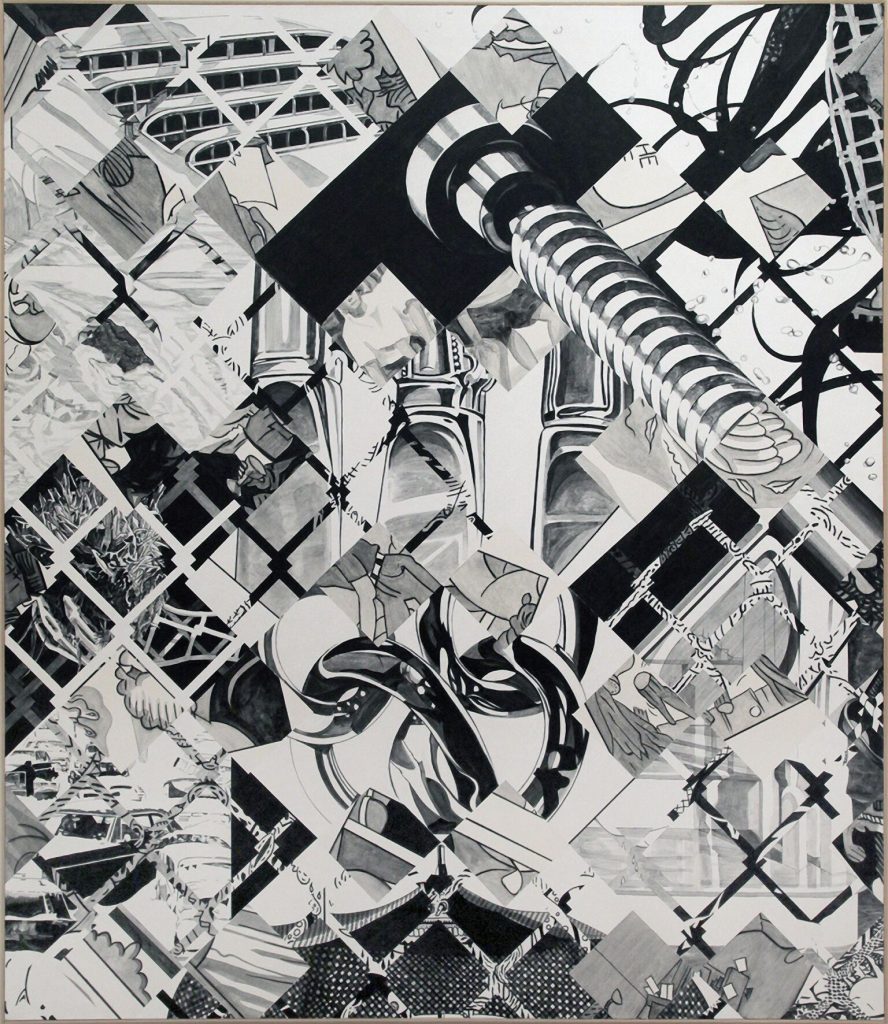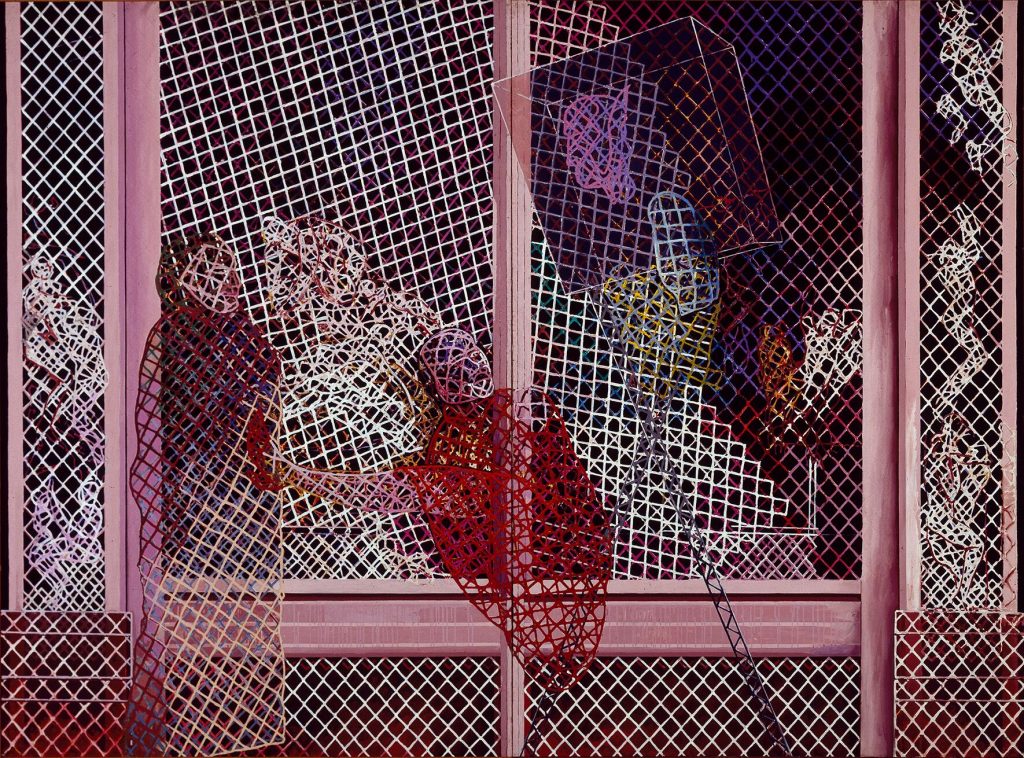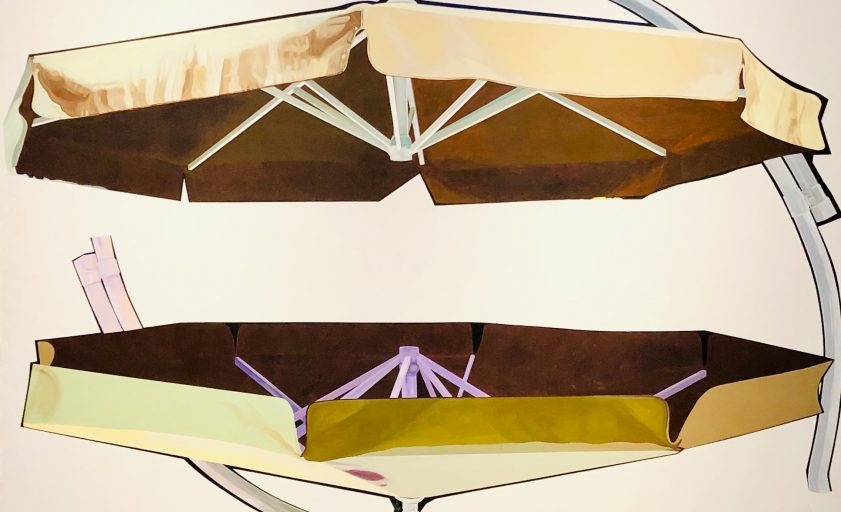By Sabrina Hughes
The Museum of Fine Arts, St. Petersburg’s newest exhibition is Theo Wujcik: Cantos, a series of works based on Dante’s Inferno. The exhibition is in turns lyrical, poetic, and dark in keeping with Wujcik’s literary inspiration for the paintings.

Like any proper epic poem, Theo Wujcik: Cantos begins with an invocation of the muses. In Dante’s second canto, he calls upon the muses to ask for creative aid in recounting his story faithfully. Wujcik’s paintings in the introductory gallery C-2-A and C-2-C, both subtitled Invocation of the Muses (1998), are not only an introduction to the themes of Cantos but also to the visual fragmentation and recombination that has come to be Wujcik’s stylistic hallmark. These first two paintings in the exhibition had at one time been part of the same canvas, but Wujcik excised these sections from the whole creating two distinct works. C-2-C, with its simple and recognizable votive holder motif paired with the
Wujcik moved to Tampa in 1970 to join the staff at Graphicstudio as a master printer at the University of South Florida. He lived and worked in Ybor City until his death in 2014. Wujcik found inspiration in comic strips and other found imagery of the mass media. Several

Wujcik’s personal symbolic structures are reworked in Cantos to metaphorically reference Dante. In Men Were We Once (Canto XIII) (1997), red drapery and a white button-down shirt represent Virgil and Dante. In this canto, the travelers enter the seventh circle of hell and meet those who have committed violence against themselves–suicides. These souls have been transmuted into tree stumps that speak and bleed. The empty wooden hangers directly reference both the wooden form of the souls as well as part of the punishment—that the flesh they used to “wear” now hangs like clothing among the trees. The comic strip imagery below the hangers hint at conflict and violence that they may have experienced in life, as well as the forest Dante describes in the story.
Theo Wujcik: Cantos is anchored by two large-scale paintings in the MFA’s collection: Canto II (1997) and Gates of Hell (1987).

In Inferno, it is in Canto II that Dante learns how and why Virgil was sent to him—directed by three women in heaven looking out for his well being: Beatrice, St. Lucia, and Mary. Virgil has told Dante that they must travel through hell to get back on the proper path, and while Dante is at first brave, he quickly loses his resolve. He wavers not out of fear but from self-sabotage, uncertainty, and feelings of unworthiness.
In Wujcik’s Canto II, the viewer is confronted with an overwhelming fragmentation of images—one’s eyes slide over the monochrome surface looking for purchase, something solid to focus on. The element that resolves first and most prominently, that gives the eye a place to rest, is a large bolt in the upper right quadrant. The winding threads of the bolt may reference the concentric circles of hell that Dante is about to spiral into. Three butter knives are situated in the center of the canvas, large yet somehow almost invisible among the cacophony; below them appear three chain links all rendered naturalistically while surrounding and overlaid are cartoons and the ubiquitous diamond fence. Perhaps this jumble of overwhelming image fragment foreshadow the chaos and distress that Dante will experience in hell. Or perhaps it is all of the memories that Dante is attempting to make sense of to create a coherent narrative.
The Gates of Hell references Canto III when Dante and Virgil set out into the underworld. The gates are inscribed with verse ending “Abandon hope, who enter here.” This canto describes an area called the vestibule of hell where souls reside who took no sides in life. They are not in hell but neither are they out of it—eternally trapped in the liminal doorway due to their relentless self-interest in life. The sage figure on the left, presumably Virgil, encounters one such soul who, as described by Dante, is sentenced to eternally chase a banner while themselves being chased by bees (!). Further into the pictorial space is Charon, the ferryman for the souls who are driven by celestial balance to enter hell proper.

In contrast to the thick chain link device that fragments the surface of Canto II, in Gates of Hell, the familiar device serves a different visual purpose. The figures and planes appear to be shaped from a diamond-wire armature. All are made of, behind and in front of the ubiquitous chain link motif. In this painting, the chain armatures are tantalizing. They create figures that are paradoxically solid and hollow. Like shades encountered in the underworld, they are simultaneously there and not. Rather than creating lines that obstruct and confuse the viewer’s progress through the pictorial space, here it creates and shapes the space.
The only solid elements in the painting are the pink door frame mouldings defining the edges of the space. Even these solid surfaces, however, when examined closely, reveal the chain links texturally embedded and painted over. Wujcik used paper towels, polymers, and other inclusions on the canvas surface to produce dimensionality on his otherwise relentlessly flat painting surfaces.

Cantos provides viewers a way out of Wujcik’s Inferno with the paired paintings We Must Go (Canto XXXIV) (1997) and PSST! (1997) where the exit from hell is fittingly made of cantilever patio umbrellas. In We Must Go, the horizontally-mirrored umbrella canopies float on a white ground. It is a simple yet elegant composition that so subtly references the Inferno that were it not for the title, I think a viewer would not make the connection. PSST! is a painting after a preparatory collage included in the first gallery. Here, one umbrella canopy shape is filled in with a domestic scene from what looks like an interior design publication decades old even at the time of the painting’s creation. The mirrored canopy contains fragmented comic strip imagery, juxtaposing two different rendering styles, one an idealized interior space, the other a cartoon. In Dante’s Inferno, Canto XXXIV is the final one, where Dante and Virgil have come to the center of hell where Lucifer resides in stasis. In order to leave hell, they must climb down Lucifer’s torso to a point, only visible to those who know to look for it, where a threshold is crossed, gravity is inverted, the world is topsy turvy, and they are no longer in hell. In PSST!, especially as it is in conversation with the preparatory collage where the composition is inverted, the question is which is the ninth circle of hell and which is the way out? Is the ideal home scene hell or the way out?
Wujcik’s Cantos represent a theme that he returned to over the span of more than a decade. In other words, it wasn’t a thought that was completed easily. As Dante experienced, hell is not traversed easily, and the only way out is through.
Bay Art Files contributor Sabrina Hughes holds an M.A. in Art History from the University of South Florida, with a focus on the History of Photography. Hughes has worked at the National Gallery of Art and the Museum of Fine Arts, St. Petersburg and is an adjunct instructor at USF and is the founder and principal of photoxo, a personal archiving service specializing in helping people preserve their family photos. She also has an ongoing curatorial project, Picurious, which invests abandoned slides with new life. Follow her on Instagram @sabrinahughes for selfies, hiking, and dogs, and @thepicurious for vintage photos.
Theo Wujcik: Cantos is on view at the Museum of Fine Arts, St. Petersburg through June 2, 2019. In tribute of the artist’s love of the Ybor City night club scene, the MFA’s support group The Contemporaries is hosting a dance party fundraiser “Theo’s Inferno” on Friday, May 17th at the Museum. 1980s punk and new wave tunes spun by Tampa-based DJ Gabe Echazabal, Ybor City-themed food offerings, and an open beer bar will set the retro tone for the evening. General admission is from 7 – 10 pm with an extra special VIP offering starting at 6:30 pm featuring a private tour by Susan Johnson of the Theo Wujcik Estate and MFA Curator of Contemporary Art Katherine Pill. Advance tickets available for purchase online at the Museum’s website.
Theo Wujcik: Cantos is on view at the Museum of Fine Arts, St. Petersburg through June 2, 2019. In tribute of the artist’s love of the Ybor City night club scene, the MFA’s support group The Contemporaries is hosting a dance party fundraiser “Theo’s Inferno” on Friday, May 17th at the Museum. 1980s punk and new wave tunes spun by Tampa-based DJ Gabe Echazabal, Ybor City-themed food offerings, and an open beer bar will set the retro tone for the evening. General admission is from 7 – 10 pm with an extra special VIP offering starting at 6:30 pm featuring a private tour by Susan Johnson of the Theo Wujcik Estate and MFA Curator of Contemporary Art Katherine Pill. Advance tickets available for purchase online at the Museum’s website.
The Museum of Fine Arts, St. Petersburg received generous support for this exhibition from Ann and Bill Edwards and The Gobioff Foundation.

